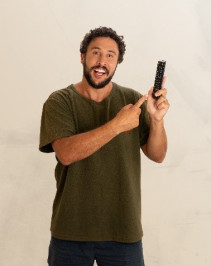Keeping up with the times: new safeguards for free-to-air television
Changes to timebands and classifications are coming to free-to-air (FTA) television on 1 May 2020.
A new campaign is launching today to tell viewers, especially parents and caregivers, what they need to know to be ready.
With the help of How To DAD Jordan Watson, the Broadcasting Standards Authority (BSA) has launched a new television, radio and print media campaign, a new website, www.safeviewing.co.nz, and an entertaining online video that aims to reach as many viewers as possible.

How to DAD Jordan Watson explains how to protect young viewers on free-to-air TV
The changes enhance the safeguards that protect children and other viewers from content that might harm them. The safeguards include programme classifications and timebands, including the 8.30pm watershed. The www.safeviewing.co.nz website also promotes the use of parental locks on free-to-air TV and has information about how to manage TV content in the home.
What changes are coming?
The decades-old PGR and AO classification labels on FTA television are retiring to make way for the more detailed G, PG, M, 16 and 18 labels, which are already used on Pay TV.
Some adjustments to timebands are also coming, but the 8.30pm watershed remains in place. G and PG content can play at any time, but no programmes rated 16 and over can air before 8.30pm. Programmes rated 18 and over can only be aired after 9.30pm.
‘M’ classified programmes can play when children are at school, between 9am and 3pm on weekdays, and after 7.30pm any day. During the weekends, school holidays and public holidays no M-rated content will be allowed until 7.30pm.
BSA Chief Executive Belinda Moffat said: “The changes are being made to keep up with the times and to reflect the changing way we watch television. At the centre of everything is the need to protect people, and tamariki in particular, from content that might harm them.
“Television provides our community with a rich source of information and entertainment, and is particularly important in our current lockdown environment. But we want our viewers, especially our tamariki, to be safe. Broadcasting standards provide some protections, and these changes are part of that.”
Children’s Commissioner Judge Andrew Becroft supports the work by the BSA and welcomes the changes.
He said: “Children enjoy watching TV to relax, learn, or to remain occupied while parents or caregivers are busy. Most, if not all, New Zealand families rely on timebands as a measure for protecting their children from unsuitable content. Even more so now, with the unprecedented nationwide lockdown we are in.
“The BSA has a role in protecting children and encouraging broadcasters to act in their best interests, so we are pleased to see the BSA and broadcasters are taking a child-centred approach and retaining the 8.30pm watershed as part of this change.”
The changes will take effect from 1 May 2020, though some viewers may continue to see the old classification labels in some places as the transition occurs.
The BSA worked with FTA broadcasters on how the changes should be implemented. The new labels will be displayed on screen and in both print and electronic programme guides. An awareness-raising campaign will run across TV, radio, print and online platforms to ensure communities can learn about the changes before they launch.
BSA Chair Judge Bill Hastings said: “There’s plenty of information on the www.safeviewing.co.nz website for parents and caregivers to find out more about the changes and to learn how to use the classifications, audience advisories and parental locks on their televisions so that they can manage content in their homes.
“Important additional safeguards are also being brought in to reduce the potential for harm to viewers, including more programme information before and during some programmes.
“Under the new Code, free-to-air broadcasters will adopt a responsible programming principle, which requires them to consider the impact of the content on the likely and target audience when scheduling programmes.”
The Code changes are reflected in the revised Codebook of Broadcasting Practice in New Zealand which has been published on the BSA’s website today, and will be available in English and te reo Māori. The revised Codebook officially takes effect on 1 May 2020.
More information can be found by visiting the BSA’s www.safeviewing.co.nz website, email info@bsa.govt.nz or call 0800 366 996
ENDS
NOTES
Classification labels will change from G, PGR, AO to G, PG, M, 16 and 18. The new classification labels have the following meanings:
G – General: Approved for general viewing
PG – Parental Guidance: Parental guidance recommended for younger viewers
M – Mature Audiences: Suitable for mature audiences 16 years and over
16 – People under 16 years should not view
18 – People under 18 years should not view
The new timebands are:
G programmes may be screened at any time
PG programmes may be screened at any time
M programmes may be screened between 9am and 3pm on weekdays (except during school and public holidays, as designated by the Ministry of Education) and after 7.30pm until 5am on any day
Programmes classified 16 may be screened after 8.30pm until 5am
Programmes classified 18 may be screened after 9.30pm until 5am
For media inquiries, please contact:
Adam Szentes, Porter Novelli
M. 021 265 1067 E. AdamS@porternovelli.kiwi
For general broadcasting standards queries:
P. 0800 366 996 E. info@bsa.govt.nz
ABOUT THE BROADCASTING STANDARDS AUTHORITY
The BSA is an Independent Crown Entity that oversees the broadcasting standards regime in New Zealand. The BSA determines complaints that broadcasts have breached standards, undertakes research and oversees the development of broadcasting standards in consultation with broadcasters.
The Authority members are Judge Bill Hastings (Chair), Paula Rose QSO and Susie Staley MNZM. The Chief Executive is Belinda Moffat.
For more information see our website: www.bsa.govt.nz